Carole McArthur, M.D. '91, Ph.D., of the UMKC School of Dentistry and UMKC School of Medicine, was part of a team of scientists who discovered a new strain of HIV.
The new subtype is referred to as HIV-1 Group M, subtype L—and is part of the Group M viruses that are responsible for the global pandemic, which can be traced back to the Democratic Republic of Congo.
"In an increasingly connected world, we can no longer think of viruses being contained to one location," said McArthur, one of the study authors. "This discovery reminds us that to end the HIV pandemic, we must continue to outthink this continuously changing virus and use the latest advancements in technology and resources to monitor its evolution."
In order to determine whether an unusual virus is a new HIV subtype, three cases have to be discovered independently. The first two for this subtype was discovered in 1980s and 1990s and this third was collected in 2001 but difficult to sequence until now.
Today, technology allows researchers to build entire genomes at higher speeds and partnering scientists at Abbott had to develop new techniques in order to confirm the discovery.
“This discovery reminds us that to end the HIV pandemic, we must continue to outthink this continuously changing virus and use the latest advancements in technology and resources to monitor its evolution.”
Mary Rodgers, Ph.D., one of the Abbott scientists who co-authored the study with McArthur, said identifying viruses like this one are like searching for a needle in a haystack; however, with new technologies it feels as though they are now “pulling the needle out with a magnet.”
“This scientific discovery can help us ensure we are stopping new pandemics in their tracks," she said.
Abbott’s Global Viral Surveillance Program monitors HIV and hepatitis viruses, specifically, to ensure the company’s diagnostic tests remain up to date. And now that this new strain has been identified, they are able to detect it.
You can read the full release here.
The study was published in the Journal of Acquired Immune Deficiency Syndromes (JAIDS).
In the News
Hundreds of outlets around the world published this discovery, including:

